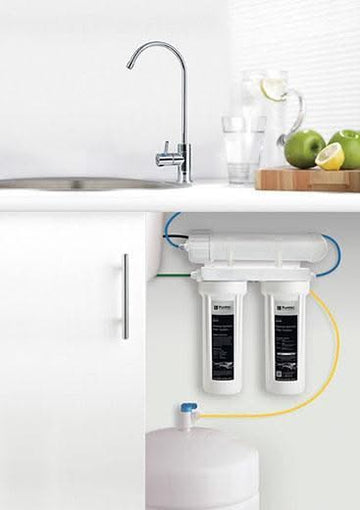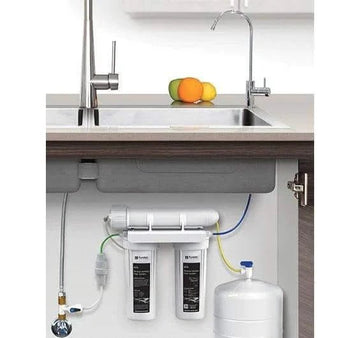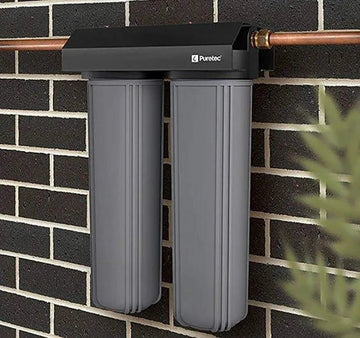How to Identify and Remove Forever Chemicals in Drinking Water
Forever chemicals in drinking water, specifically PFAS (per- and polyfluoroalkyl substances), are synthetic chemicals that don’t break down easily, posing serious health risks such as cancer, hormone disruption, and immune system issues. This guide will help you understand what PFAS are, how they contaminate water, and what steps you can take to remove them from your drinking water supply.
Key Takeaways
✅ PFAS, known as ‘forever chemicals,’ persist in the environment and have been linked to serious health risks, including certain cancers and immune system disorders.
✅ Industrial discharges, firefighting foams, and landfills are the main sources of PFAS contamination, highlighting the need for stricter regulations and better treatment methods.
✅ Effective filtration technologies such as activated carbon, reverse osmosis, and ion exchange resins are crucial for removing PFAS from drinking water and ensuring public health safety.
What Are Forever Chemicals in Drinking Water?
PFAS (per- and polyfluoroalkyl substances) are a class of man-made chemicals known for their resistance to heat, water, and oil. Their durability comes from strong carbon-fluorine bonds, making them extremely persistent in the environment. Because they don’t degrade naturally, they accumulate in water, soil, and even in the human body—hence the name “forever chemicals.”
Where Are PFAS Found?
PFAS have been widely used since the 1940s in a variety of consumer and industrial products, including:
🛢 Non-stick cookware (Teflon)
👕 Water-repellent clothing
🍔 Fast food packaging
🔥 Firefighting foams
🏭 Industrial coatings and lubricants
Due to their widespread use, water contamination from PFAS is a growing concern, affecting municipal supplies, private wells, and natural water sources.
Health Risks of PFAS in Drinking Water
Even low levels of PFAS exposure can lead to serious health problems, including:
🩺 Cancer – PFAS exposure has been linked to kidney and testicular cancer.
💉 Immune System Damage – Reduced vaccine effectiveness and weakened immune responses.
🩸 Hormonal Disruptions – Affecting thyroid function and sex hormone levels.
👶 Developmental Issues – Low birth weight and potential birth defects.
❤️ Increased Cholesterol – Higher risk of heart disease and stroke.
⚖️ Decreased Fertility – Impacts reproductive health in both men and women.
Because PFAS bioaccumulate in the body, their health effects worsen over time, making it essential to reduce exposure wherever possible.
How PFAS Get Into Drinking Water
PFAS contamination occurs through multiple pathways, including:
1. Industrial Discharges
🏭 Factories that produce or use PFAS in products such as plastics, coatings, and electronics release these chemicals into water systems through wastewater.
2. Firefighting Foams
🔥 Aqueous Film-Forming Foams (AFFF) used in firefighting training and emergency response contain high levels of PFAS, which seep into groundwater and surface water.
3. Landfills & Wastewater Treatment Plants
🚮 PFAS leach from landfills and enter water supplies, while wastewater treatment plants often fail to remove PFAS effectively.
These persistent chemicals travel long distances, contaminating wells, rivers, lakes, and reservoirs used for drinking water supplies.
Current Regulations & Guidelines for PFAS in Drinking Water
🌏 Regulations on PFAS vary globally, with some countries setting stricter limits than others.
🔬 In the U.S., the EPA has established maximum contaminant levels (MCLs) for PFOA and PFOS at 4 parts per trillion (ppt)—one of the strictest standards in the world.
🇦🇺 In Australia, the Department of Health recommends monitoring and reducing PFAS levels in drinking water, though enforceable limits vary by state.
🚰 Some areas, like Queensland, have introduced water quality monitoring programs to track and manage PFAS contamination.
While regulatory measures are improving, removing PFAS at home remains the best solution for protecting your health.
How to Remove PFAS from Drinking Water
Most standard water filters (like Brita) do not effectively remove PFAS. You need advanced filtration technologies designed to target these persistent chemicals.
Top Filtration Methods for PFAS Removal
1. Reverse Osmosis (RO) – Best Overall
💧 Removes up to 99% of PFAS, as well as heavy metals, fluoride, and other contaminants.
🛠 Uses a semi-permeable membrane to filter particles as small as 0.0005 microns.
🏡 Ideal for under-sink systems in homes.
🛠 Recommended System:
✅ Puretec RO270 Reverse Osmosis System – High-efficiency RO unit for comprehensive water purification.
2. Activated Carbon Filtration – Best for Large Households
🌿 Uses carbon adsorption to trap PFAS molecules in a dense carbon block filter.
💰 More affordable than reverse osmosis but requires regular filter changes.
⚠️ Not as effective as RO for very high PFAS levels.
🛠 Recommended System:
✅ Puretec CF Series Undersink Water Filter System – Removes PFAS, chlorine, and organic compounds.
3. Ion Exchange Resins – Best for High PFAS Levels
🔬 Uses charged polymer beads to attract and remove PFAS molecules.
📈 Highly effective, especially when combined with RO or activated carbon filtration.
🛠 Recommended System:
✅ Puretec ESR2-T5 Reverse Osmosis System – Multi-stage filtration system with reverse osmosis, activated carbon, and ion exchange resins.
Steps to Reduce PFAS Exposure at Home
Besides installing a high-quality water filter, you can minimize PFAS exposure by:
🚫 Avoiding non-stick cookware (use stainless steel or cast iron instead).
👕 Choosing PFAS-free clothing and furniture (check labels on water-resistant gear).
🍔 Reducing fast food consumption (PFAS are used in grease-proof packaging).
🛢 Properly disposing of old PFAS-containing products (firefighting foams, stain-resistant sprays).
The Future of PFAS Research & Regulation
As scientific understanding of PFAS health risks grows, more countries are implementing stricter regulations.
💰 The U.S. EPA has allocated $2 billion to help communities reduce PFAS contamination.
🌏 Australia continues to monitor and update water safety guidelines.
🏭 Industries are developing PFAS-free alternatives for consumer products.
While regulations continue to evolve, the best defense remains home water filtration and informed consumer choices.
Summary: Protect Your Drinking Water from PFAS
🔹 PFAS ("forever chemicals") are toxic, persistent, and linked to serious health risks.
🔹 Main sources include industrial waste, firefighting foams, and landfills.
🔹 Reverse osmosis, activated carbon, and ion exchange are the most effective removal methods.
🔹 Puretec RO270, CF Series, and ESR2-T5 systems provide high-quality filtration.
🔹 Avoid PFAS-containing products to further reduce exposure.
The best way to protect yourself? Invest in a high-quality water filtration system and stay informed on PFAS regulations. 💧
Frequently Asked Questions (FAQ)
❓ Can boiling water remove PFAS?
❌ No. PFAS do not break down with heat, so boiling is ineffective.
❓ Do Brita filters remove PFAS?
❌ No. Standard water filters do not capture PFAS.
❓ Is bottled water PFAS-free?
⚠️ Not always. Some brands contain detectable PFAS levels.
📢 Best solution? Install a reverse osmosis or activated carbon filtration system for safe, clean water. 🚰































